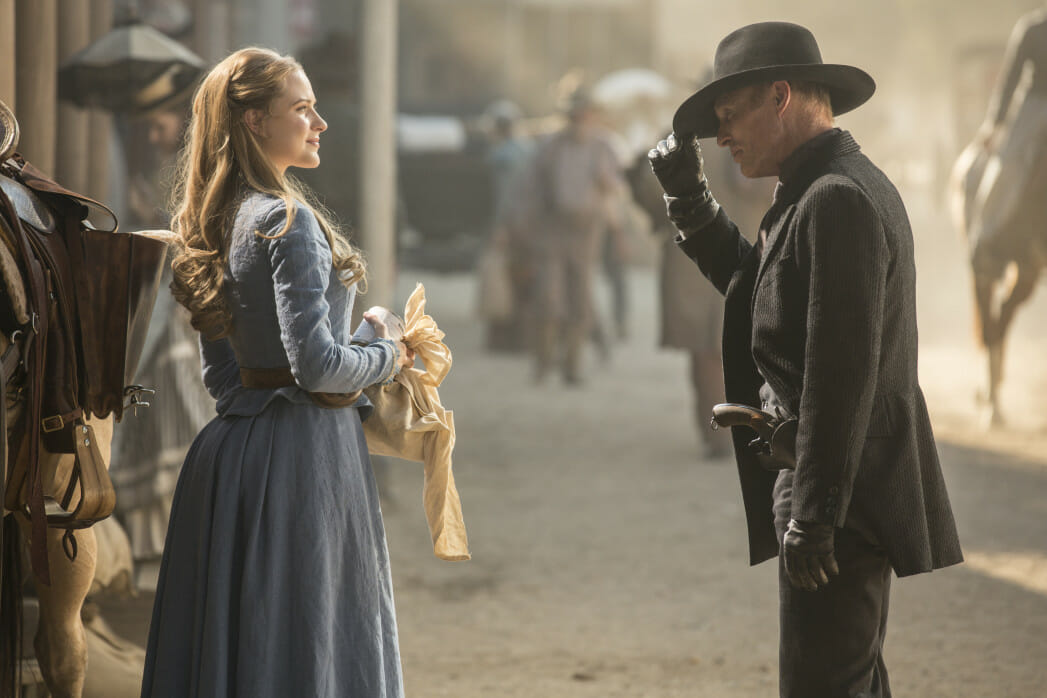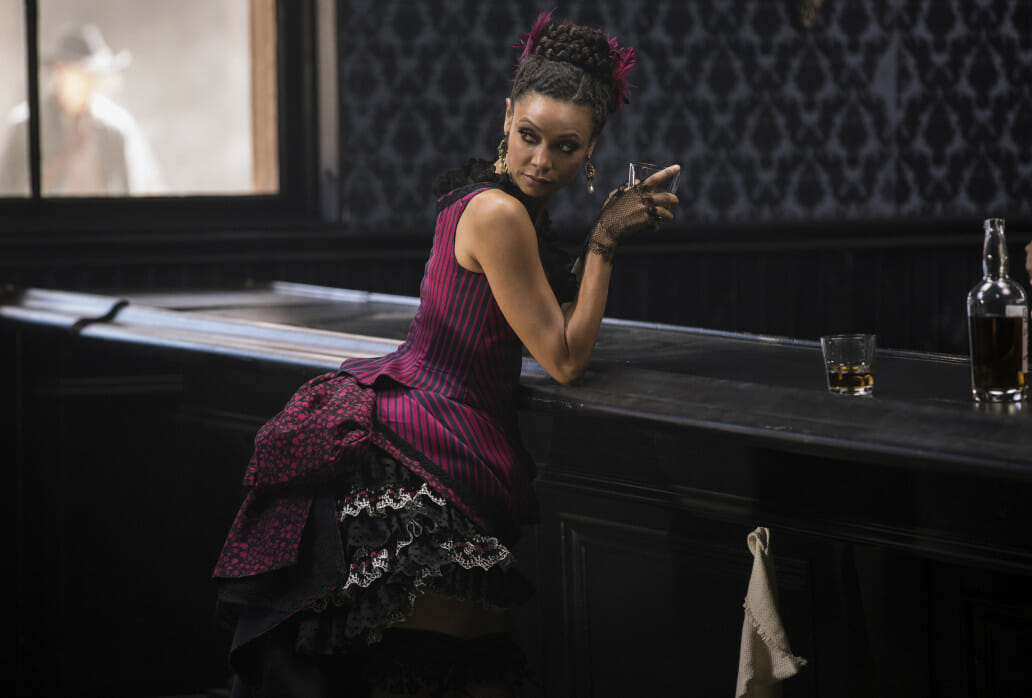
9 March 2020
Westworld: Recap of Seasons 1 and 2
Forget about cowboys and Indians. Westworld is all about cyborgs, gadgets, gizmos and getting to play make-believe. Okay, and cowboys and Indians.
Westworld has layers, meaning upon meaning. But don’t let this deter you from joining from Season 3, as the plot moves from the Western-styled theme park to a whole new world: the human world. It’s a chance for new Westworld fans to dip their toes into this cerebral sci-fi series, without having to watch the previous two seasons.
A recap of what went down in the first two seasons:
A world apart
Here’s what you need to know about the Westworld town of Sweetwater: everything is fake! From the horses and outlaws to the ranchers, their cattle and the brothel. Everyone who lives in Sweetwater and its surrounding ranches is a host, human-like androids running highly sophisticated artificial intelligence.
Westworld itself is fake – it’s a theme park owned and run by the Delos Corporation. It’s where really rich people go to play make-believe. They pay to be cowboys or the mayor, a lawman or a patron at the local watering hole/saloon/brothel. Whatever their heart desires. And in doing so they commit atrocious acts with or against the robotic hosts, who are programmed to play along. Be prepared for a lot of nudity, a lot of violence, a lot of graphic visual material.
The theme park and its robotic hosts were created by Robert Ford, played by actor Sir Anthony Hopkins. The hosts’ duties in Westworld are to live out narratives determined by Ford and his team that is headed up by his second-in-command Bernard (Jeffrey Wright). At the end of each narrative, the hosts have their memories wiped.

Because the narratives within the theme park repeat, you’ll see Dolores (Evan Rachel Wood) greet her rancher dad Peter (Louis Herthum) up to five times in one episode – but you’re not going mad, says Evan. “You forget which loop and which day you’re in. Especially because you’re playing a scene that you genuinely have to be in and be feeling but you know in the back of your head is completely scripted, twice. It’s a script of a script. It’s just a rabbit hole of confusion.”
The slightest change in the narratives influences entire timelines, explains Wood: “Dropping that can (of tinned fruit) over and over again. The slight variations on them, if one little thing gets thrown, then the whole story changes. That’s part of the fun [of the show], but as an actor, it’s weird because you’re doing the same scene over and over with slight variations. So learning lines was weird, remembering which episode you were in was weird.”

Danger zone
So what’s so amazing about the sci-fi show? The machines are learning their places in the world, developing a human-like conscious – and they’re not happy. A couple of updates to their software systems have bombed out and characters like Dolores and brothel madam Maeve Millay (Thandie Newton) are revolting against the establishment.
Maeve, in particular, is dangerous as a host because she is having memories of her past storylines that should’ve been wiped – especially her and her daughter being attacked in their little house on the Prairie. Her only objective is to find the girl and rescue her.

It’s when Maeve wakes up during a routine maintenance update that the problem really begins. “Maeve is walking around [the Delos Corps laboratory] looking at the artistry of how the hosts are created. She realises the full extent of what they are as creations [when she sees her friends and other hosts that she knows, like prostitute Clementine Pennyfeather, played by Angela Sarafyan] and that they’re not human. I mean, that’s just such a betrayal,” explains Thandie.
Maeve, who by design is meant to be intuitive and a problem solver, pieces the clues together. And because she’s a rough brothel madam who handles drunken fools daily, bullying the Delos nerds and geeks is child’s play – she starts by ordering them to increase every function in her host brain. She tweaks everything from intelligence to puzzle solving to military warfare, while at the same time reducing anything that could hinder her, like emotion.
Man-made monsters
It’s not just Dolores and Maeve who are a problem. The humans having fun in the theme park are just as troublesome. Some are falling in love with their hosts, not grasping that it’s all fake. Others are looking at the big picture and how this world of make-believe is the future and will make them a lot of money. But while the human guests can be and are stopped in their tracks (Maeve forces Westworld’s engineers to remove software laws that prevent the hosts from injuring humans), the hosts are far tougher to get rid of. That’s thanks to the fact that Ford has had thousands of them kept in storage, so when one body is damaged, their host brain can be transplanted and they carry on as if nothing happened.

While Westworld feels very similar to the Terminator movie franchise with the robots taking over (obviously a whole lot prettier to look at, thanks to the beautiful people and beautiful landscapes), Westworld is far more than just a sci-fi show. It’s a warning about emotion, it’s a warning about playing with the mind and things that we do not fully understand.
The more you think you know, especially in Season 2 (and there are other worlds and theme parks that come into play during the season), the more you realise that you know nothing. Watching as the hosts revolt, how cruel and vindictive and focused they are, mankind is in serious trouble. And the worst part is that the show is only just getting started…
Watch the Westworld S3 trailer
Westworld S4 is now streaming on Showmax with new episodes every Monday, express from the US.
Want a recap of Season 3 before starting Season 4? Read our article here.
SA celebs open up about divorce on Untied
The action heats up on Empini
More Mzansi gold

The Mommy Club: Van Die Hoofstad S1
Stream the reunion of the hit Showmax Original reality show, featuring five dynamic, wealthy women from Pretoria as they manage relationships, families, businesses, and busy social lives, on 27 June and 4 July 2025.

Eye-opening homegrown documentaries to stream
These unmissable South African shows and movies deliver surprising insights on the country we’re living in today.

20+ addictive South African reality shows to stream
Stream The Catch, The Real Housewives of Durban, The Mommy Club, and more of South Africa’s best reality shows on Showmax.

MaBlerh returns to host The Real Housewives of Durban reunion
MaBlerh returns to host The Real Housewives of Durban reunion for the third year in a row. The Season 5 reunion drops in two parts on 4 July and 11 July 2025.
